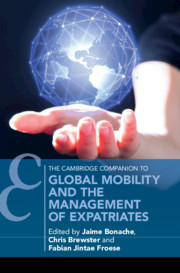Book contents
- Global Mobility and the Management of Expatriates
- Cambridge Companions to Management
- Global Mobility and the Management of Expatriates
- Copyright page
- Contents
- Figures
- Tables
- Contributors
- 1 Global Mobility
- Part I The Expatriation Process of Corporate Expatriates
- 2 The Recruitment, Selection, and Preparation of Expatriates
- 3 Expatriate Adjustment
- 4 Performance Management for Expatriates
- 5 Compensating Global Mobility
- 6 Repatriation and Career Development
- Part II Different Types of Expatriates and Stakeholders
- Index
- References
3 - Expatriate Adjustment
from Part I - The Expatriation Process of Corporate Expatriates
Published online by Cambridge University Press: 12 November 2020
- Global Mobility and the Management of Expatriates
- Cambridge Companions to Management
- Global Mobility and the Management of Expatriates
- Copyright page
- Contents
- Figures
- Tables
- Contributors
- 1 Global Mobility
- Part I The Expatriation Process of Corporate Expatriates
- 2 The Recruitment, Selection, and Preparation of Expatriates
- 3 Expatriate Adjustment
- 4 Performance Management for Expatriates
- 5 Compensating Global Mobility
- 6 Repatriation and Career Development
- Part II Different Types of Expatriates and Stakeholders
- Index
- References
Summary
Adjustment is the process of changing behaviour, feelings, and cognitions to achieve a balance with the environment. Adjustment is needed whenever an individual transfers from a familiar setting to an unfamiliar setting to interact effectively and to feel a sense of belonging. Expatriates experience adjustment in the cognitive, affective, and behavioural dimensions and across different domains such as for example work, culture, and personal domains. The needed change includes new routines and uncertainty which might cause anxiety. Adjustment to the new situational context is essential for expatriation success. In this chapter, we examine what we have learnt from the literature. We discuss antecedents to adjustment and critically reflect on the most common approaches to analysing expatriate adjustment. Furthermore, new alternatives on how to understand adjustment that mitigate the limitations of previous models will be highlighted and we will provide insights on how to apply a holistic assessment. Finally, we will provide our readers with some practical and research implications.
- Type
- Chapter
- Information
- Global Mobility and the Management of Expatriates , pp. 57 - 79Publisher: Cambridge University PressPrint publication year: 2020
References
- 2
- Cited by



